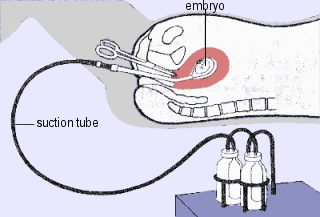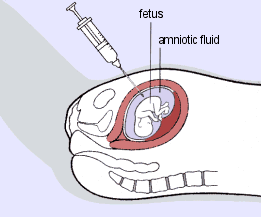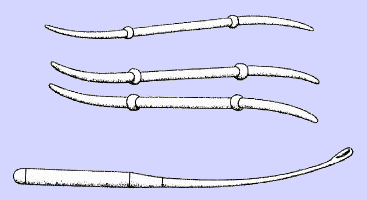|
4.5.1 ABORTION METHODS
It makes a great difference whether an abortion is performed early or late in the pregnancy. The earlier it is done, the better. During the first 12 weeks of pregnancy, an abortion is a relatively safe and simple procedure which usually does not require an overnight stay in the hospital. After the 12th week, there is a greater risk of complications, more difficult techniques have to be used, and hospitalization for at least a few days is often necessary. Naturally, a late abortion is also more expensive. After the 20th week, a voluntary abortion, even where it is legal, is usually considered medically indefensible except in the most extraordinary cases. By this time, the fetus has developed to a point where it could actually survive a premature birth. For this and other reasons, most doctors will refuse to perform an abortion at this late stage.
It is important to remember that every abortion, even if done early, is a medical operation which can, under certain circumstances, result in complications. Still, the search for newer and safer abortion methods continues. Some experimental methods involve prostaglandins (substances that contribute to the contraction of uterine muscles). These substances can cause delivery at any stage of the pregnancy. However, since this method still needs to be perfected it is not yet generally available. Any pills, injections, or other abortifacients that can now be obtained either over or under the counter involve grave risks and do not work.
A woman who considers having an abortion should be familiar with the various medically recognized and well-established abortion methods. Thus, she will know what to expect at her doctor's office or at the hospital. Perhaps even more important, she will also be able to judge the techniques of a criminal abortionist and recognize medical incompetence before it threatens her life. Methods other than those described here are either ineffective or dangerous or both.
METHODS USED IN EARLY ABORTIONS
Menstrual Regulation
The usual pregnancy tests do not become reliable until about 40 days or more after the last menstrual period. Women who suspect that they are pregnant but do not want to wait that long to find their suspicion confirmed can ask a gynecologist for a simple procedure called variously menstrual regulation, menstrual aspiration, menstrual extraction, or preemptive abortion. This procedure is similar to the one used for inserting intra-uterine devices (lUDs). Just as in the case of an IUD insertion, the doctor inserts a small tube through the cervix into the uterus. However, instead of depositing the IUD through the tube, he applies a vacuum at one of its ends, thus pulling out (i.e., "aspirating" or "extracting") the lining of the uterus which would normally be shed in menstruation. The procedure takes only a few minutes and can easily be performed in a doctor's office. Obviously, the term "abortion" for this procedure is applicable only if the woman is indeed in the first stages of pregnancy. If she is not pregnant and her menstrual period is simply delayed for another reason, a term like "menstrual regulation" is more appropriate. The procedure is mostly designed to fill the gap between "foresight contraception" and "hindsight abortion". It is a fairly new method and may not yet be available everywhere in the United States.
Suction
The suction method, also known as "vacuum curettage" or "uterine aspiration" is today the safest and most commonly used medical technique for an early abortion. After a dilation of the cervix, a tube attached to a suction pump is inserted into the uterus. The pump, which operates on the same principle as a vacuum cleaner, sucks the embryo and the placenta out of the uterus through transparent tubes into a collection bottle. The entire operation takes only a few minutes.
DILATORS IN VARIOUS SIZES
THREE ABORTION METHODS
1. Dilation and Curettage
The picture shows some cervical dilators and a curette. The dilators arc used to apart the cervix for both the older D & C and the modern suction method (see below). The curette is used only for the D&C method to scrape the embryo and placenta from the uterine wall.
2. Suction

An instrument is clamped to the cervix in order to hold it in position, and a suction tube is then inserted through the dilated cervix into the uterus, sucking the embryo into a bottle.
3. Saline Injection

A needle is inserted into the uterus through the abdominal wall. Some of the amniotic fluid is removed and replaced with concentrated salt water which then kills the fetus.
Dilation and Curettage
This older technique, also known simply as "D & C", is in principle not too different from the suction method. Again, the cervix is dilated. However, there is no tube and no vacuum pump. Instead, the entire operation is performed by hand. A surgical instrument with a hollowed out, spoon-like tip is inserted into the uterus. This instrument is called a curette. The doctor uses it to scrape the embryo and placenta from the uterine wall. The operation usually takes about 15 minutes.
METHODS USED IN LATE ABORTIONS
Saline Injection
This method, also known as "salting out", consists of replacing some of the fluid surrounding the fetus with salt water. This is done by inserting a long, hollow needle through the abdomen into the amniotic sac inside the uterus. The salt water kills the fetus. The uterus starts contracting usually within the next two days, resulting in the delivery of the dead fetus.
Hysterotomy
Hysterotomy can be described as a miniature Caesarean section. Fetus and placenta are removed through an incision in the abdomen. This is major surgery requiring hospitalization for several days. A woman who has had a hysterotomy (not to be confused with a hysterectomy, or removal of the uterus) can become pregnant again, but usually needs a Caesarean section every time she wants to give birth.
REFERENCE AND RECOMMENDED READING
The Boston Women's Health Book Collective. Our Bodies, Ourselves. 2nd ed. New York: Simon & Schuster, 1976 (cloth); 1976 (paper).
Bradley, Robert A. Husband-Coached Childbirth, rev. ed. New York: Harper & Row.1974.
Colman, Arthur D, and Libby. Pregnancy: The Psychological Experience. New York: Continuum Books, 1971.
Demarest, Robert, and Sciarra, John. Conception, Birth, and Contraception: A Visual Presentation. 2nd ed. New York: McGraw-Hill. 1976.
Dick-Read, Grantley. Natural Childbirth Primer. New York; Harper & Row, 1956.
Lamaze, Fernand. Painless Childbirth: The Lamaze Method. Chicago: Henry Regnery Company, 1970 (cloth); New York: Pocket Books, 1976 (paper).
Leboyer, Frederick. Birth Without Violence. New York: Knopf, 1975.
Noonan, John T., ed. Morality of Abortion: Legal & Historical Perspectives. Cambridge, Mass. and London: Harvard University Press, 1970 (cloth); 1970 (paper).
|



